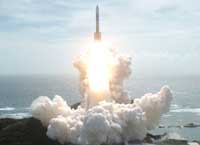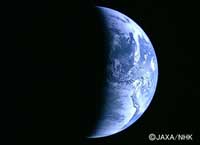|
FLYING TO THE MOON
Lunar Probe Successfully Launched
(November 1, 2007)
|
|
Launched on an H2A No.13 rocket on September 14 from the Tanegashima Space Center in Kagoshima Prefecture, Japan's first large-scale lunar probe is the largest lunar mission since the United States' Apollo space program. Currently in orbit around the moon, the probe, Kaguya, is named after a beautiful princess in a Japanese fairy tale who was born from a bamboo tree and left Earth to return to her home on the moon when she grew up. High-Precision Equipment Satellites typically carry enough instruments to measure three or four environmental variables, but Kaguya comes equipped with no less than 14 types of observation equipment. Each piece was produced in Japan and boasts a degree of accuracy anywhere from 10 to 100 times greater than previous models. Kaguya will use both gamma- and X-ray fluorescence spectrometers to examine the moon's elemental distribution and a multi-band imager and spectral profiler to look at mineral distribution. Terrain cameras, laser altimeters, and lunar radar sounders will be used to inspect the surface and subterranean structures beneath the crust of the moon. A lunar magnetometer will evaluate magnetic anomalies, and a charged particle spectrometer and PACE (Plasma Energy Angle and Composition Experiment) will provide measurements on the surrounding environment. An upper-atmosphere and plasma imager will be used to measure things like the Earth's plasmasphere from the moon. Plans for Moon Landing After launch, Kaguya deployed its solar panels and high-gain antennas, which keep it in contact with mission control, as well as correcting its orbit. On its way to the moon, on October 1 the satellite took video footage of the Earth from 110,000 kilometers away using a high-definition camera, the farthest ever high-definition filming of our planet. On October 4th, Kaguya entered orbit around the moon. After Kaguya detaches its relay and VRAD satellites, it will be launched into a stationary observational orbit about 100 kilometers from the surface of the moon in late October, before performing an inspection on its observation equipment in early November. In mid-December it will begin gathering data on the moon. In total, Kaguya is expected to be in use for about a year. Scientists are using Kaguya not only to make scientific observations but also to develop a variety of technologies, such as ways to launch objects into the moon's orbit and control their attitude, course, and temperature once in orbit. Following Kaguya, the Japan Aerospace Exploration Agency has unveiled plans for a probe to land on the moon in the 2010s. |
Copyright (C)2007 Web Japan. Edited by Japan Echo Inc. based on domestic Japanese news sources. Articles presented here are offered for reference purposes and do not necessarily represent the policy or views of the Japanese Government.

